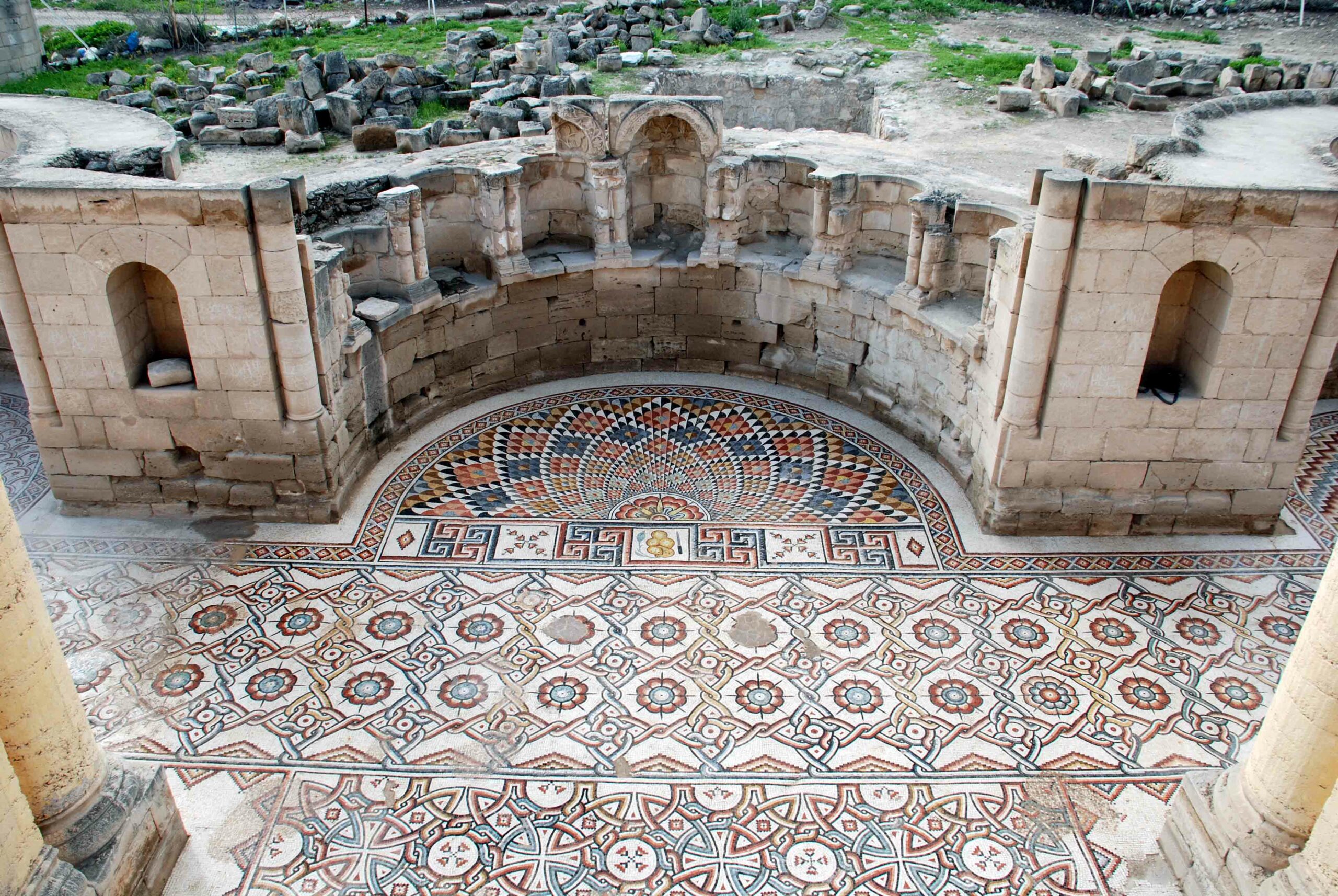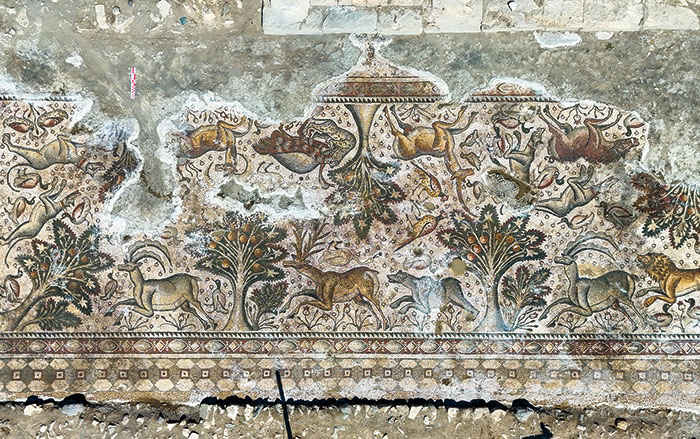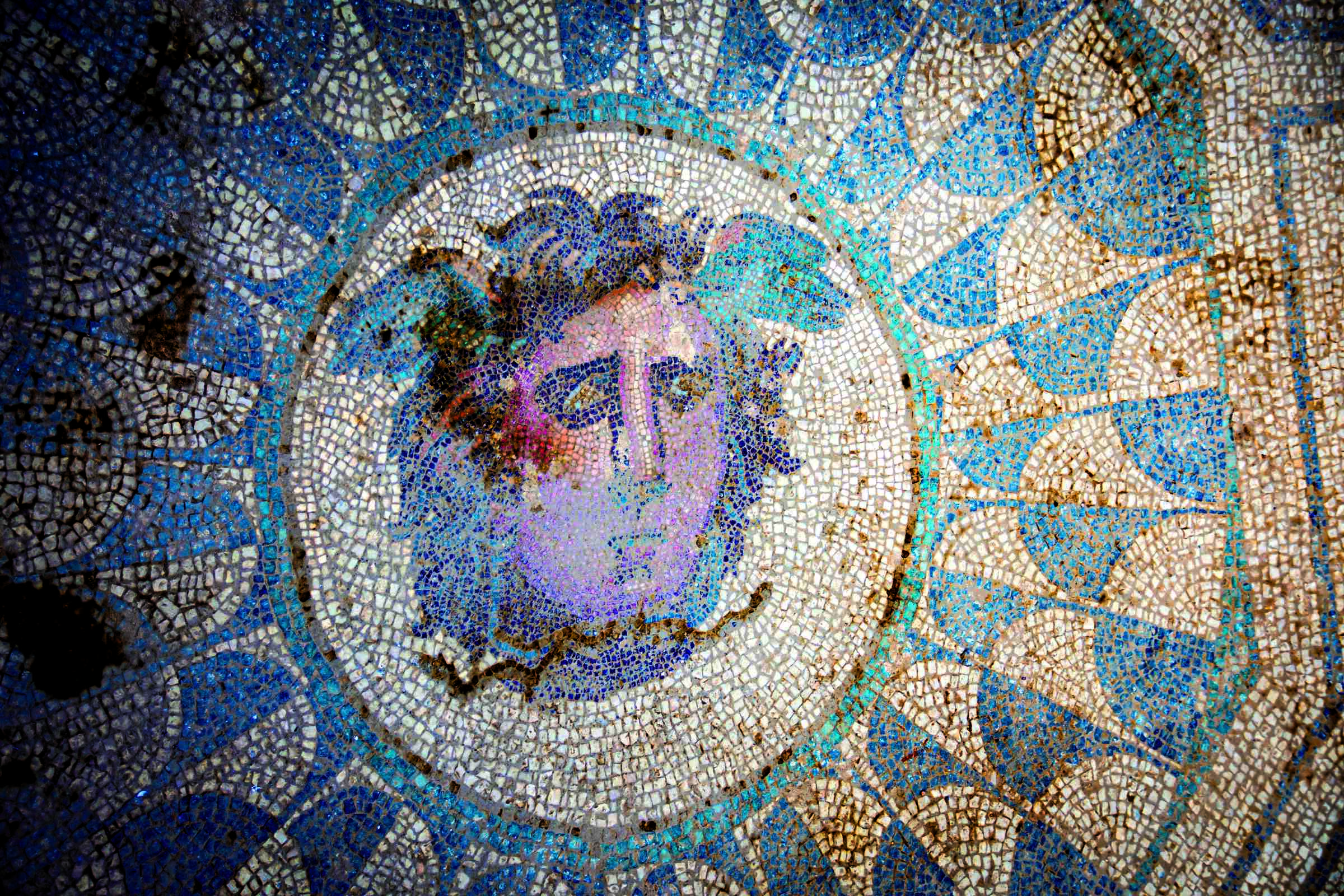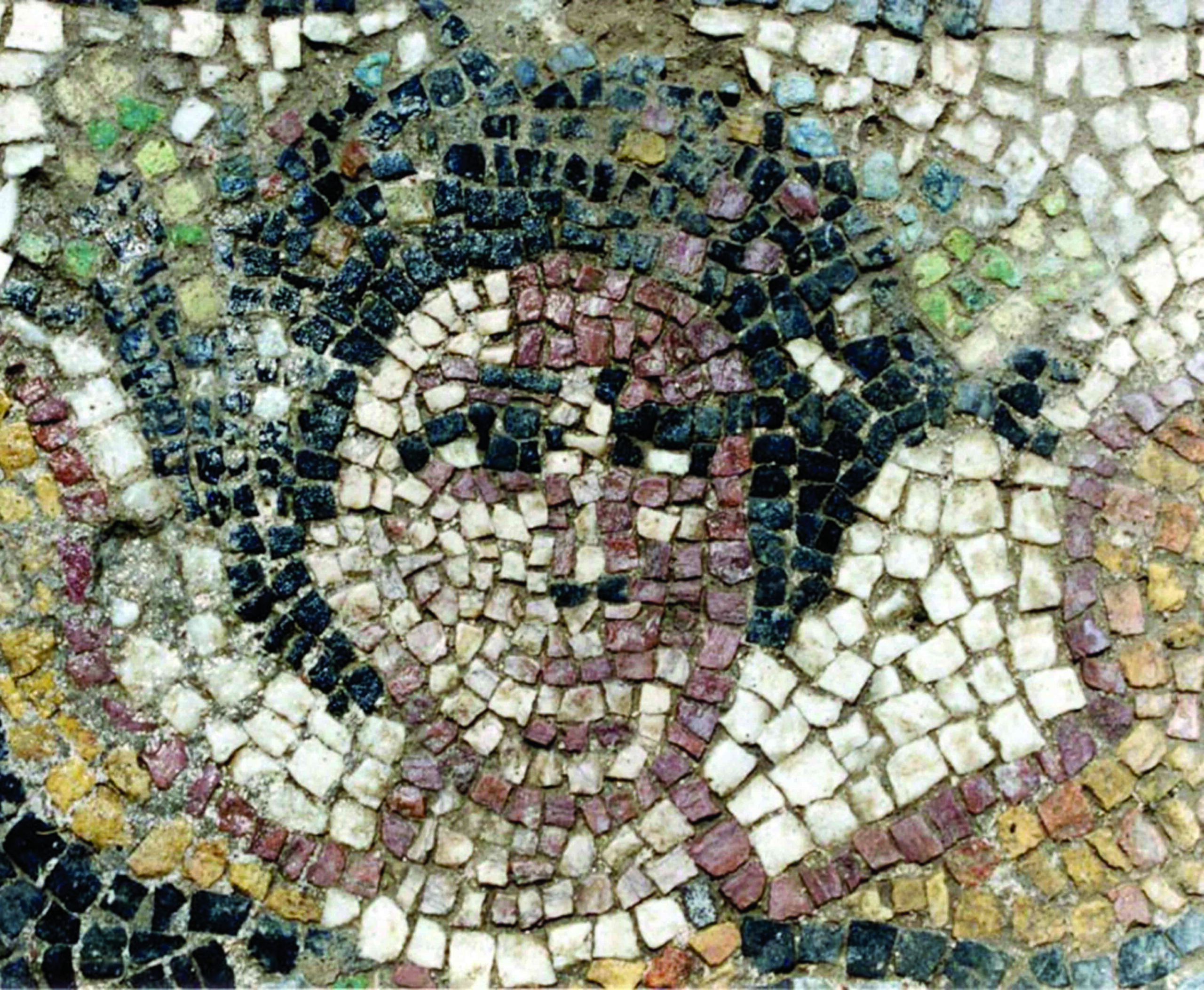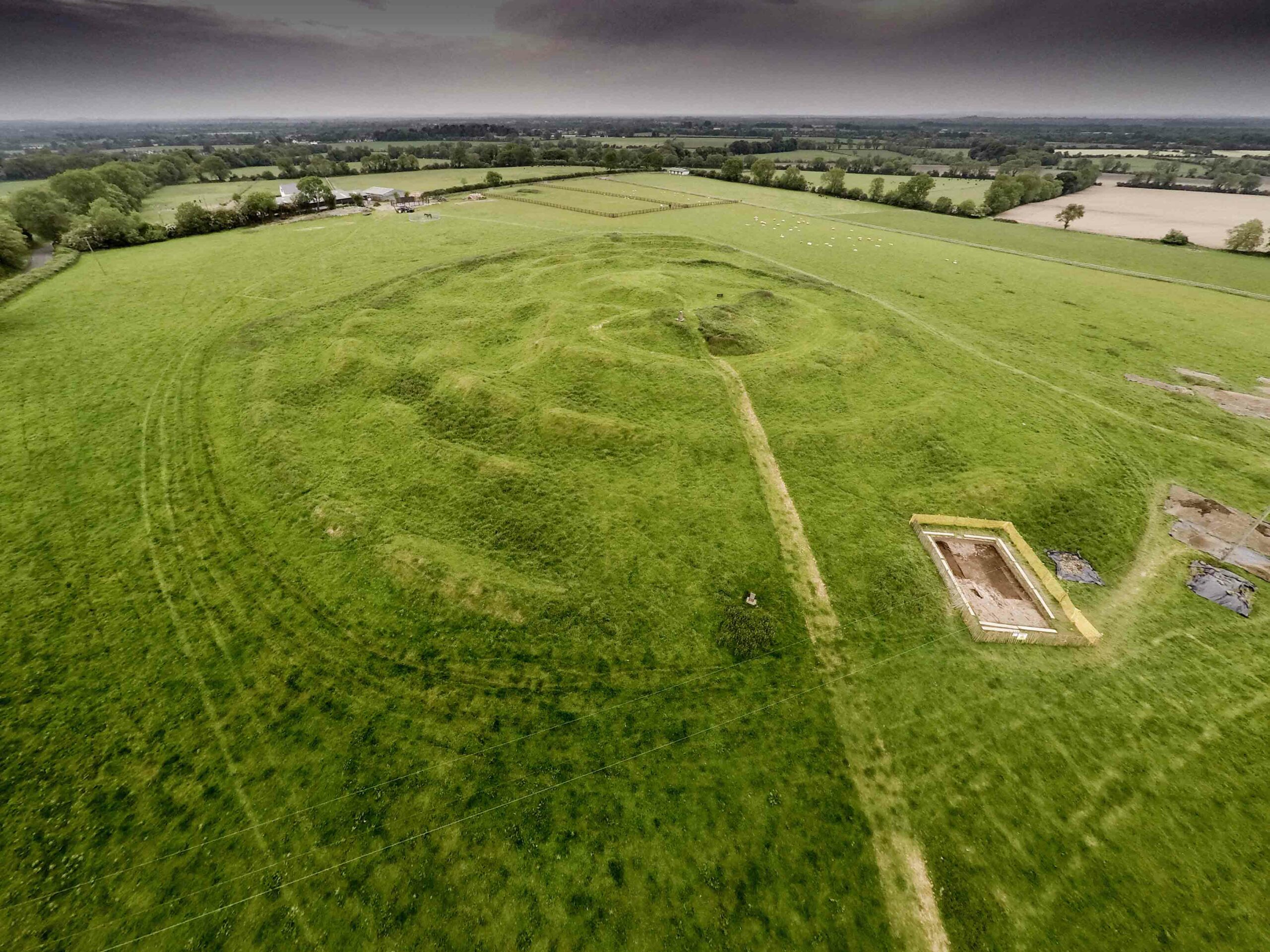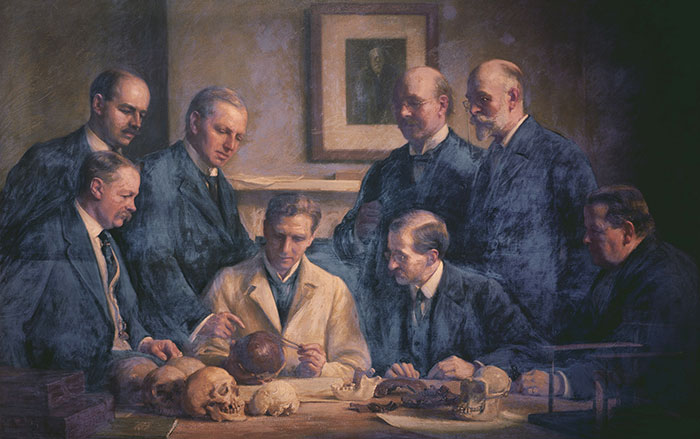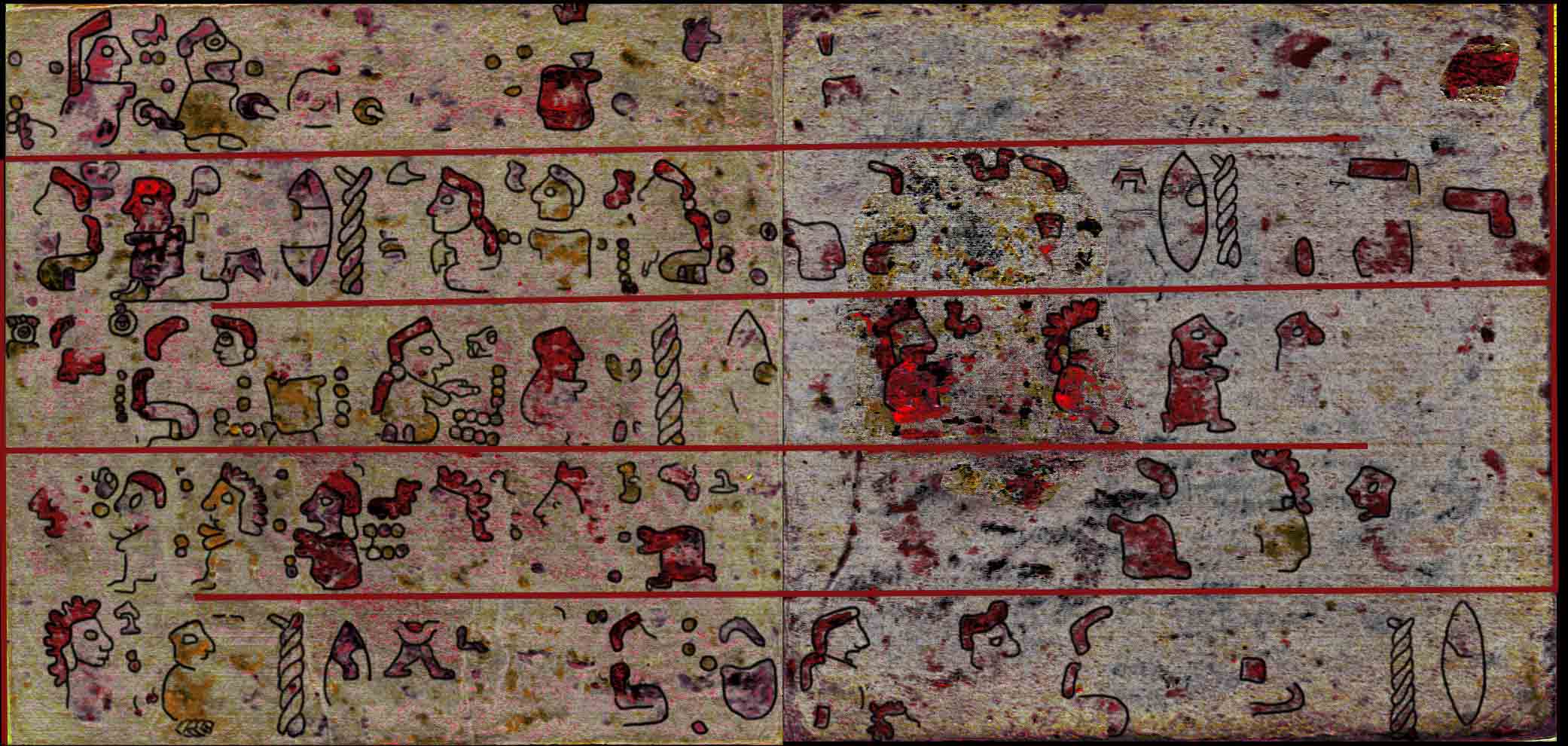
In 1935, Dmitri Baramki, a young archaeologist working for the British administration in his native Palestine, began excavating three dirt mounds outside the ancient city of Jericho 25 miles east of Jerusalem. Baramki was concerned that important evidence of a Byzantine church or monastery inside the mounds was being destroyed by the locals’ habit of pilfering and reusing the ancient stones for building material. However, he soon realized that what he had found was not a Christian religious building at all, but instead, the remains of an eighth-century Islamic palace.
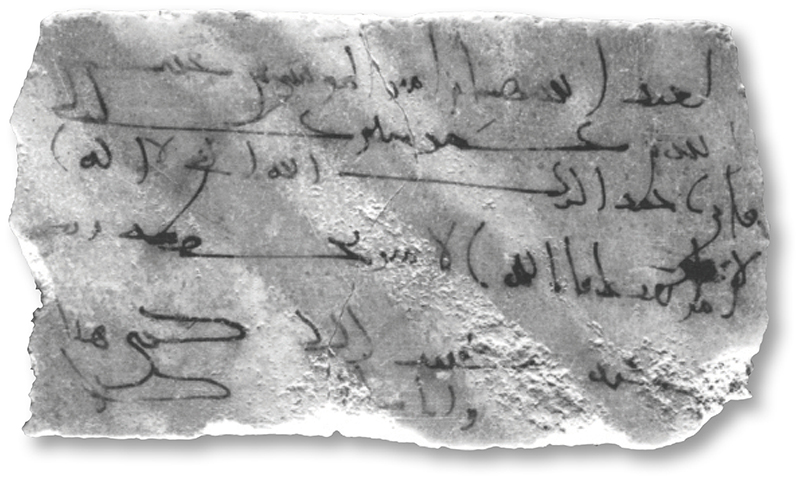
Though much of the palace complex was in shambles, likely destroyed by an earthquake in A.D. 747, Baramki’s team nevertheless unearthed detailed mosaics and stuccowork of the highest quality that once had decorated the palace’s walls and floors. Baramki also discovered a white marble ostracon inscribed in ink in Arabic reading “Hisham, commander of the faithful.” The phrase is probably the opening of a letter, and is the only writing found at the site. Local residents, who had previously called the mounds Khirbet al-Mafjar, “Ruins of Flowing Water,” for their location near an aqueduct, began referring to them as “Hisham’s Palace.” Soon archaeologists concluded that the palace had been built during the reign of Hisham ibn Abd al-Malik, the tenth Umayyad caliph (r. A.D. 724-743), Islam’s chief religious and political leader.
The Umayyads were a merchant family from Syria who converted to Islam in 627. Islam’s founder, Muhammad, died in 632 without leaving a clear system of succession, ushering in a period of strife. By 661 the Umayyads had ascended to the caliphate, having won the first of many wars fought for leadership of the religion and its growing sphere of influence. The first Umayyad caliph, Muawiyah ibn Abi Sufyan, moved the caliphate’s capital from Medina, in what is now Saudi Arabia, to Damascus, in modern-day Syria, where the family already had high standing, thereby boosting the power and legitimacy of the new leader. For 89 years the Umayyads reigned over an empire stretching from India to Spain. Their fragile hold on power was constantly threatened by various groups claiming rights to the caliphate, and they ultimately lost several key military battles to the Abbasid Dynasty, who finally wrested away control in 750.
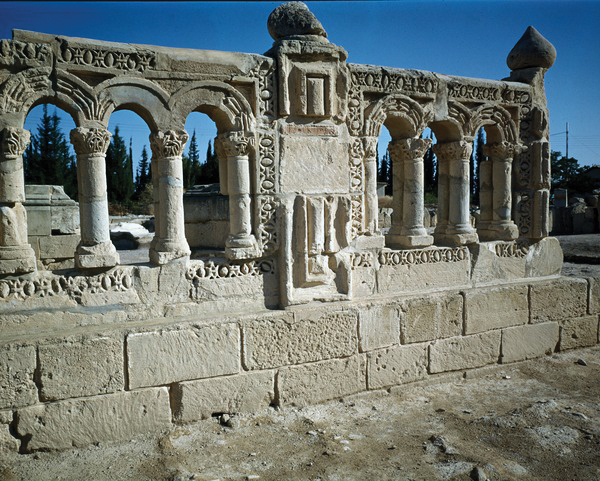
Robert W. Hamilton was the head of the British Mandate for Palestine’s Department of Antiquities who oversaw Baramki’s excavations at Khirbet al-Mafjar and eventually joined him at the dig in the later 1940s. The sumptuous nature of the palace, much more extensively decorated than other Umayyad desert compounds found across the Middle East, could, thought Hamilton, only be fully explained by linking it to one particular short-lived caliph—a nephew of Hisham named Walid ibn Yazid, known from later Islamic writers for his love of music, wine, and women. “It existed for reasons which must be sought not in the realm of public affairs but in that of personal pleasure,” Hamilton wrote in his 1959 book, Khirbat al-Mafjar: An Arabian Mansion in the Jordan Valley. In another book, Walid and His Friends, Hamilton relates a story from the tenth-century text of Islamic historian Abu al-Faraj al-Isfahani about Walid bathing in a tub of wine, and then emerging intoxicated with the level of wine in the tub significantly lowered. Al-Isfahani does not mention where this episode took place, but Hamilton writes that it occurred in the palace’s bathhouse.
Hamilton determined that Khirbet al-Mafjar was abandoned after Walid was killed in 744—allegedly assassinated by a family member for his wild behavior. “Walid and all his company, his singers, his horses and hounds, his builders and his girls were totally forgotten,” Hamilton writes. “Only the name of ‘al Mafjar,’ meaning ‘where water gushes out,’ or, by a quirk of language, less agreeably ‘the place of fujur (debauchery)’ may still be whispering to their ghosts of ancient pleasures dimly remembered.” With Baramki’s publications not well known, and the reports from the only other excavation of the site by a team of Jordanians in the 1960s lost, Hamilton’s emerged as the dominant narrative of the site.

Scholars today are quick to point out Hamilton’s colonial motivations, saying he, like many Europeans at the time, viewed Islamic culture as a mix of the backward and the exotic. Aside from a few late nineteenth- and early twentieth-century explorers, European powers had only entered the Middle East recently, at the end of World War I, establishing colonial mandates that lasted through World War II in what are now Syria, Lebanon, Israel, and other countries. The same scholars also note that the Islamic historians Hamilton relies on are widely viewed as biased against the Umayyads because they were writing under the Abbasid Caliphate, and had an interest in portraying its predecessors as corrupt and impious in order to promote Abbasid legitimacy. “Hamilton’s writings have cast this particular monument in a very superficial role in Islamic architecture,” says Donald Whitcomb, a University of Chicago archaeologist who, along with the Palestinian Authority’s Department of Antiquities and Cultural Heritage, is now leading the Jericho Mafjar Project. “I don’t deny that the Umayyads had some good parties, but I don’t think it was the purpose of the site.”
Now, thanks to Whitcomb and his team’s work, the story of Khirbet al-Mafjar is becoming one of nearly 400 years of long-lasting cultural, economic, and political achievement, rather than a few years of a wayward caliph’s escapades. And instead of casting the palace as an anomaly, this new understanding offers insights into the early development of Islamic cities, how the Umayyads sought to exert control and influence over an area mainly inhabited by Christians and nomadic Bedouins, and the persistence of culture even under shifting political, economic, and religious circumstances.
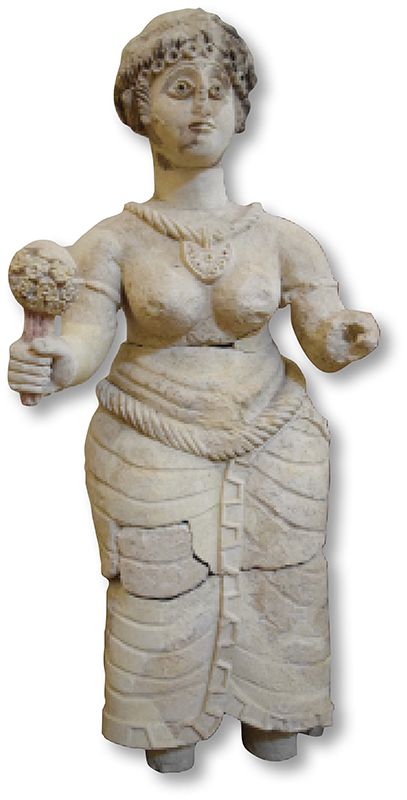
During Baramki’s and Hamilton’s original excavations, which covered more than 3.5 acres, they unearthed the remains of an impressive complex composed of a palace, bathhouse, courtyard, and mosque, all surrounded by defensive walls. The palace’s interior walls and ceilings are covered in extravagantly carved stucco in whimsical patterns, along with human and animal figures. Much of the imagery is derived from both the Greek and pre-Islamic Persian Sasanian Empires. Brick vaulting echoes building techniques from ancient Iraq. The floor plan of the palace, consisting of rooms arranged around a central courtyard, is reminiscent of those of the Romans. “There is no doubt there is something about this architecture that is an inheritance from pre-Islamic tradition,” says Katia Cytryn-Silverman, a Hebrew University of Jerusalem expert in Islamic archaeology.
The Umayyads not only esteemed the beauty of the imagery of their predecessors, explains Cytryn-Silverman, they were also employing styles associated with these powerful empires of the past in order to affirm their own present authority. “This was a time when pre-Islamic tradition was followed and admired,” Cytryn-Silverman says. “In this melting pot of past and present empires, the Umayyads were still looking for their language of expression and ways to demonstrate their rulership.
Baramki and Hamilton also uncovered an expansive polychrome mosaic floor measuring nearly 9,000 square feet, making it one of the largest intact mosaics found in this part of the world. The geometric patterns and borders on the mosaic lend it the look of a carpet lining the floor, and, in fact, some tesserae are laid out to look like tassels at the edges of a rug. One alcove in the bathhouse contains a mosaic known as the “Tree of Life,” which depicts two peaceful gazelles separated by a tree from a lion attacking another gazelle. The arrangement has been widely interpreted by Islamic art historians as an Umayyad expression of their desire for political and cultural power, using imagery dating back to ancient Persia and Mesopotamia, where the lion represented royalty. Depictions of lions attacking other animals dating from the Byzantine age have also been uncovered in Jordan and Syria, and the Umayyads would have been familiar with these as well. “The lion often represents power, and this scene is inspired by illustrations from other sites,” says Mahmoud Hawari, an archaeologist and research associate at Oxford’s Khalili Research Centre for the Art and Material Culture of the Middle East, who has studied Khirbet al-Mafjar and other desert castles. Hawari believes that the scene also symbolizes the battle of good versus evil. “The composition of the scene is quite unusual, reflecting how the Umayyads were a hybrid of several civilizations, and we see this in their culture, their art, their way of life.”
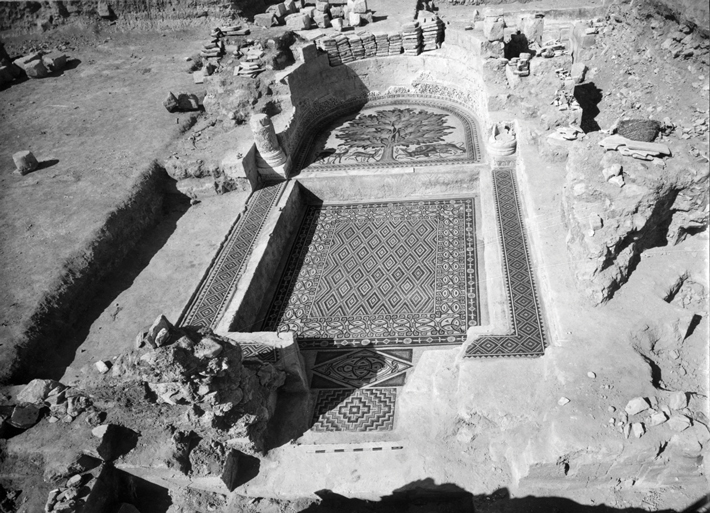
While on a fellowship in Amman, Jordan, almost 30 years ago, Whitcomb came across Baramki’s writings. He was particularly intrigued by the earlier archaeologist’s challenge of the idea that Khirbet al-Mafjar was abandoned in 747, and the hints Baramki drops that he thought the site may have a longer legacy: “In the twelfth century it was poorly reconditioned, apparently by newcomers—could they have been some of the troops of Saladin? Pottery and coins left behind by these passing occupants range from the eighth to the thirteenth centuries,” Baramki writes in one of his preliminary reports. Whitcomb first published an article in 1988 on the topic of when and if the site was actually abandoned, and eventually, in 2011, he began renewed excavations.

EXPAND
The Palace's Other Lives
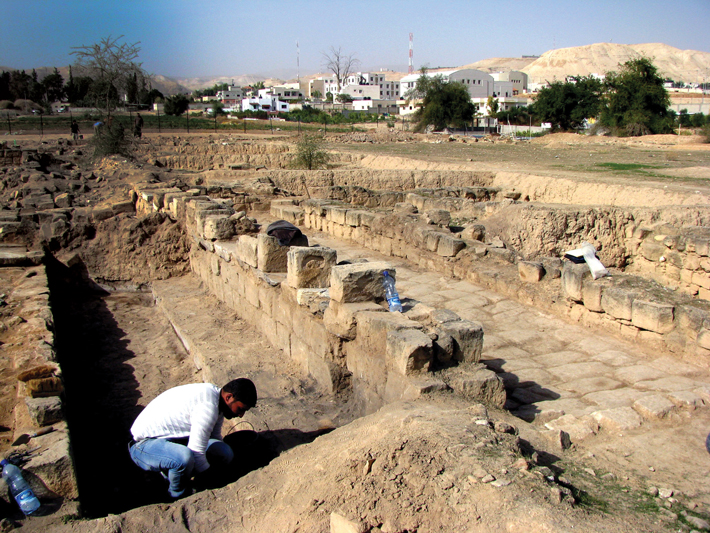
The extensive damage to the structures of Khirbet al-Mafjar led one of the original excavators, Robert W. Hamilton of the British Mandate for Palestine’s Department of Antiquities, to conclude in the 1940s that the complex had been largely destroyed by an earthquake known to have hit the region in A.D. 747. Dmitri Baramki, an archaeologist who worked there during the same time, suggested in his writing that he thought it persisted longer.
The team working there currently, led by Donald Whitcomb of the University of Chicago and Hamdan Taha, the recently retired director of the Palestinian Department of Antiquities and Cultural Heritage, has uncovered new evidence to support Baramki’s theory. They have discovered buildings from the ninth and tenth centuries, when the caliphate was ruled by the Abbasids, who overthrew the Umayyads in 750. An Abbasid manor house, horse stables, and mosque were found north of the original palace in the area that had been the Umayyad agricultural estate. The Abbasid buildings were simple compared to the highly decorated Umayyad ones, and the later builders reused some remnants of earlier structures. Marble from the Umayyad pavilion was employed to construct a toilet in the Abbasid residential complex, and the formal hallway was found paved with stones from the older Umayyad gates. “It was a very economical reuse of available resources,” Taha says, adding that the Abbasid buildings appeared to be constructed hastily, directly on the soil rather than on stone foundations. This, he explains, is a sign that the estate was no longer being used by royalty, but instead by a rural family.
Whitcomb says that the original Umayyad palace complex was likely repurposed as housing for workers. He bases this on Baramki’s notes in which he recorded finding building materials and pottery dating all the way through the twelfth century inside the original palace and bath complex, including “intrusive walls” and sun-dried bricks that imply the large compound was divided up into smaller, more utilitarian rooms.
Although Whitcomb didn’t excavate the original palace and bath complex this time around, his team did carry out remote sensing and ground-penetrating radar studies in these areas. Beneath the ruins of the palace complex they identified several walls and what appears to be a rectangular building with a central courtyard surrounded by a series of rooms. This has brought up a new question: Could the site possibly have been a Roman site centuries before the area was chosen by the Umayyads for a strategic royal settlement? This can likely only be answered through additional digging, something that is not planned for now.
Over the last several winters, the joint Chicago-Palestinian team’s work has doubled the size of the site Baramki and Hamilton first explored. They have uncovered an agricultural estate connected to the palace compound, which, says Whitcomb, shows that Khirbet al-Mafjar was not simply a place for royal relaxation, but had an economic function, and might even have been a small city. The recent work has also established its classification as one of the “desert castles,” a term used to refer to a few dozen Umayyad estates found in the region. Aside from some remote sensing investigations, the team did not re-excavate the palace and bath complex. It is, however, something that Whitcomb says could be interesting, especially in determining later, post-Umayyad uses and identifying a potential earlier, Roman structure in the area. The original palace and bath area are now an archaeological park, with rows of columns, parts of walls, and some large stucco installations reconstructed in the 1950s by a team from the Rockefeller Museum in Jerusalem while the area was under Jordanian control.
The new evidence of the extensive remains beyond the palace walls is now providing a fuller picture of the economic importance of Khirbet al-Mafjar and challenging the characterization of the Islamic conquest as ushering in a period of economic downturn. Archaeologist Michael Jennings of the University of Chicago, who is part of the team, explains that such previous assumptions have relied too heavily on accounts of seventh- and eighth-century European Christian pilgrims to the region. Archaeology has now shown that the estate consisted of planting fields, horse-training areas, and a large wine press. The sheer size of the press and the great number of glass vials, storage jars, and large collection of charred date seeds, indicates agricultural production on a scale for commercial use. “This changes the whole idea of the history of the site,” says Jennings. It demonstrates that prosperity from large-scale agriculture, a legacy of the Jericho oasis from as early as the first century B.C., continued into the Islamic period. At that time the area evolved from subsistence farming to the beginnings of selling cash crops of dates, wine grapes, and balsam (or turpentine), and was watered by a sophisticated series of aqueducts.
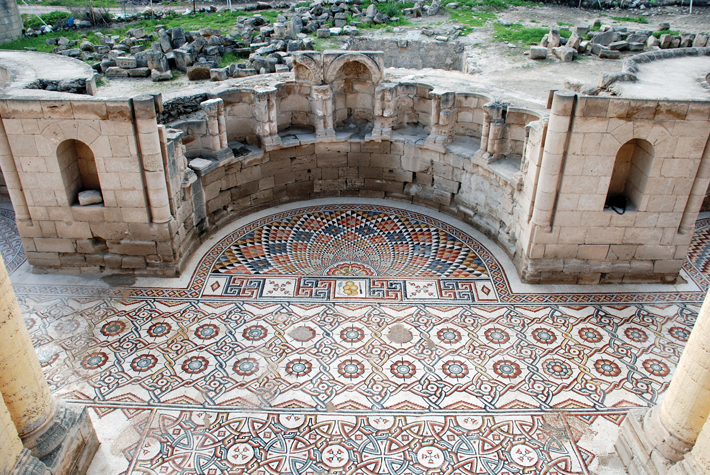
In addition, this latest research is expanding scholars’ understanding of the means by which the Umayyads sought political and religious influence over rural Arab tribes, who could work on the agricultural estate. It was likely that the Umayyads welcomed local tribal leaders into the palace’s large audience hall to entertain them, convert them to Islam, and forge political alliances. These were the keys to maintaining their hold on power in the new Islamic empire, Jennings explains, in a manner similar to the way in which Christians used networks of rural monasteries to exert political and religious influence.

Work at Khirbet al-Mafjar also has much to say about the impression that customs and mores change immediately upon the introduction of a new culture through conquest. The wine press challenges that idea. Jennings calls the press the most elaborate and well-constructed example in the entire region. It had a brick roof, white mosaic floor, and crushing machinery, and was housed in a building made from the same local ashlar sandstone masonry as the palace and bathhouse. He acknowledges that the site, with its wine press and nude statuary, doesn’t always square with ideas people have about the history of Islam. Instead, scholars have demonstrated that Islam’s ban on alcohol and human imagery only gained traction later and has varied in its stringency by place and time. “It just shows that cultural change doesn’t happen the same moment political change does,” Hawari says. “Wine was part and parcel of Umayyad culture and we even see this reflected in their poetry and songs. People don’t switch their habits overnight.” Hamdan Taha, a former director of the Palestinian Department of Antiquities and Cultural Heritage, concurs, explaining that the wine press, along with the art from the site, is further evidence of how the Umayyads, even while introducing a new religion into the region, still clung to existing cultural practices. “The material at Khirbet al-Mafjar shows that the Umayyads didn’t see any contradiction between their art and their religion,” Taha says, “and understood how they could coexist.”
Although the new excavations have delivered a more nuanced picture of Khirbet al-Mafjar, they haven’t provided proof of which Umayyad royal figures commissioned the palace and who spent time there. Was it Hisham, Walid, or perhaps someone else? Like Baramki, who gave his son the middle name Hisham, and Hamilton, who spent years writing about Walid’s supposed escapades in the palace, Whitcomb and Taha don’t have all the answers. “We are dealing with a place where we don’t have a tight connection between people and the monument,” Whitcomb says. “It’s a serious problem.” Whitcomb would like to keep digging. But Taha walked in the fields north of the palace for years before the renewed excavations, saw unexplored remains poking out of the ground, and even conducted his own small-scale excavation in 2006—and he feels that the understanding of Khirbet al-Mafjar is as clear as it will be for now. “I think the digging is probably over for this generation,” Taha says. “Leaving something for the next generation is also important.”


